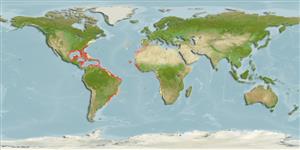Environment: milieu / climate zone / depth range / distribution range
Ökologie
seewasser riff-verbunden; tiefenbereich 2 - 275 m (Ref. 4727), usually 3 - 30 m (Ref. 40849). Tropical; ? - 28°C; 43°N - 35°S, 98°W - 14°E
Western and Eastern Atlantic.
Length at first maturity / Size / Gewicht / Alter
Maturity: Lm 23.5 range ? - ? cm
Max length : 60.0 cm TL Männchen/unbestimmt; (Ref. 7251); common length : 30.0 cm TL Männchen/unbestimmt; (Ref. 5217); max. veröff. Gewicht: 5.4 kg (Ref. 4699); max. veröff. Alter: 14 Jahre (Ref. 128045)
Rückenflossenstacheln (insgesamt): 3; Rückenflossenweichstrahlen (insgesamt): 29-32; Afterflossenstacheln 0; Afterflossenweichstrahlen: 27 - 29. Greenish or bluish gray on back, orange-yellow on lower part of head and abdomen, with two broad diagonal curved bright blue bands running from snout to below and in front of pectoral fins, the lowermost continuous with a blue ring around lips; a broad blue bar across caudal peduncle, and blue sub-marginal bands in median fins (Ref. 13442).
Found over rocky or coral areas (Ref. 5217). May form schools, sometimes solitary over sand and grassy areas. Feeds mainly on benthic invertebrates (Ref. 4727). It preys on sea urchins by blowing water to overturn it and then attacks it where the spines are short (Ref. 9710). Excellent food fish but occasionally can cause intoxication due to the liver.
Robins, C.R. and G.C. Ray, 1986. A field guide to Atlantic coast fishes of North America. Houghton Mifflin Company, Boston, U.S.A. 354 p. (Ref. 7251)
IUCN Rote Liste Status (Ref. 130435)
Bedrohung für Menschen
Poisonous to eat
Nutzung durch Menschen
Fischereien: weniger kommerziell; Sportfisch: ja; Aquarium: Kommerziell
Mehr Information
ReferenzenAquakulturAquakultur ProfilZuchtlinienGenetikElectrophoresesVererbbarkeitKrankheitenVerarbeitungNutrientsMass conversion
Tools
Zusatzinformationen
Download XML
Internet Quellen
Estimates based on models
Preferred temperature (Ref.
123201): 22.5 - 28, mean 25.9 °C (based on 694 cells).
Phylogenetic diversity index (Ref.
82804): PD
50 = 0.5078 [Uniqueness, from 0.5 = low to 2.0 = high].
Bayesian length-weight: a=0.02818 (0.02342 - 0.03391), b=2.94 (2.89 - 2.99), in cm total length, based on LWR estimates for this species (Ref.
93245).
Trophic level (Ref.
69278): 3.8 ±0.1 se; based on diet studies.
Widerstandsfähigkeit (Ref.
120179): mittel, Verdopplung der Population dauert 1,4 - 4,4 Jahre. (K=0.15-0.57).
Fishing Vulnerability (Ref.
59153): Moderate to high vulnerability (54 of 100).
Nutrients (Ref.
124155): Calcium = 26.5 [11.1, 71.0] mg/100g; Iron = 0.509 [0.261, 1.159] mg/100g; Protein = 18.8 [17.5, 20.0] %; Omega3 = 0.147 [0.086, 0.260] g/100g; Selenium = 55.9 [27.7, 119.1] μg/100g; VitaminA = 38.8 [10.7, 149.4] μg/100g; Zinc = 0.768 [0.513, 1.158] mg/100g (wet weight);
